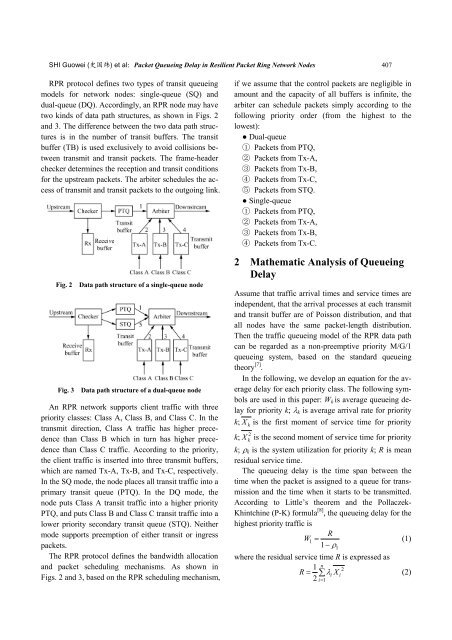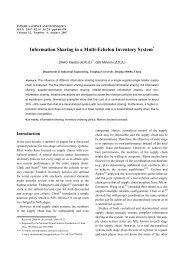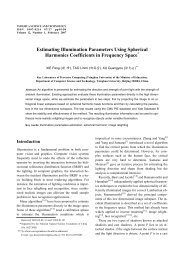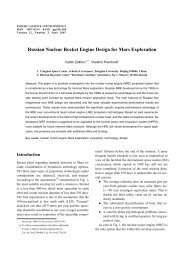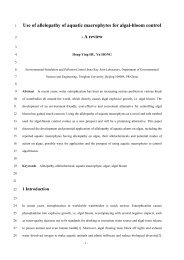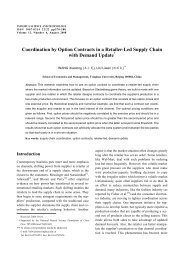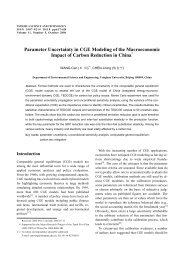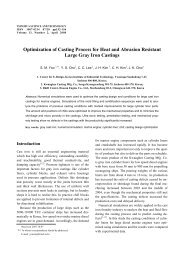Packet Queueing Delay in Resilient Packet Ring Network Nodes
Packet Queueing Delay in Resilient Packet Ring Network Nodes
Packet Queueing Delay in Resilient Packet Ring Network Nodes
Create successful ePaper yourself
Turn your PDF publications into a flip-book with our unique Google optimized e-Paper software.
SHI Guowei (史国炜) et al:<strong>Packet</strong> <strong>Queue<strong>in</strong>g</strong> <strong>Delay</strong> <strong>in</strong> <strong>Resilient</strong> <strong>Packet</strong> R<strong>in</strong>g <strong>Network</strong> <strong>Nodes</strong> 407<br />
RPR protocol def<strong>in</strong>es two types of transit queue<strong>in</strong>g<br />
models for network nodes: s<strong>in</strong>gle-queue (SQ) and<br />
dual-queue (DQ). Accord<strong>in</strong>gly, an RPR node may have<br />
two k<strong>in</strong>ds of data path structures, as shown <strong>in</strong> Figs. 2<br />
and 3. The difference between the two data path structures<br />
is <strong>in</strong> the number of transit buffers. The transit<br />
buffer (TB) is used exclusively to avoid collisions between<br />
transmit and transit packets. The frame-header<br />
checker determ<strong>in</strong>es the reception and transit conditions<br />
for the upstream packets. The arbiter schedules the access<br />
of transmit and transit packets to the outgo<strong>in</strong>g l<strong>in</strong>k.<br />
Fig. 2 Data path structure of a s<strong>in</strong>gle-queue node<br />
Fig. 3 Data path structure of a dual-queue node<br />
An RPR network supports client traffic with three<br />
priority classes: Class A, Class B, and Class C. In the<br />
transmit direction, Class A traffic has higher precedence<br />
than Class B which <strong>in</strong> turn has higher precedence<br />
than Class C traffic. Accord<strong>in</strong>g to the priority,<br />
the client traffic is <strong>in</strong>serted <strong>in</strong>to three transmit buffers,<br />
which are named Tx-A, Tx-B, and Tx-C, respectively.<br />
In the SQ mode, the node places all transit traffic <strong>in</strong>to a<br />
primary transit queue (PTQ). In the DQ mode, the<br />
node puts Class A transit traffic <strong>in</strong>to a higher priority<br />
PTQ, and puts Class B and Class C transit traffic <strong>in</strong>to a<br />
lower priority secondary transit queue (STQ). Neither<br />
mode supports preemption of either transit or <strong>in</strong>gress<br />
packets.<br />
The RPR protocol def<strong>in</strong>es the bandwidth allocation<br />
and packet schedul<strong>in</strong>g mechanisms. As shown <strong>in</strong><br />
Figs. 2 and 3, based on the RPR schedul<strong>in</strong>g mechanism,<br />
if we assume that the control packets are negligible <strong>in</strong><br />
amount and the capacity of all buffers is <strong>in</strong>f<strong>in</strong>ite, the<br />
arbiter can schedule packets simply accord<strong>in</strong>g to the<br />
follow<strong>in</strong>g priority order (from the highest to the<br />
lowest):<br />
● Dual-queue<br />
① <strong>Packet</strong>s from PTQ,<br />
② <strong>Packet</strong>s from Tx-A,<br />
③ <strong>Packet</strong>s from Tx-B,<br />
④ <strong>Packet</strong>s from Tx-C,<br />
⑤ <strong>Packet</strong>s from STQ.<br />
● S<strong>in</strong>gle-queue<br />
① <strong>Packet</strong>s from PTQ,<br />
② <strong>Packet</strong>s from Tx-A,<br />
③ <strong>Packet</strong>s from Tx-B,<br />
④ <strong>Packet</strong>s from Tx-C.<br />
2 Mathematic Analysis of <strong>Queue<strong>in</strong>g</strong><br />
<strong>Delay</strong><br />
Assume that traffic arrival times and service times are<br />
<strong>in</strong>dependent, that the arrival processes at each transmit<br />
and transit buffer are of Poisson distribution, and that<br />
all nodes have the same packet-length distribution.<br />
Then the traffic queue<strong>in</strong>g model of the RPR data path<br />
can be regarded as a non-preemptive priority M/G/1<br />
queue<strong>in</strong>g system, based on the standard queue<strong>in</strong>g<br />
theory [7] .<br />
In the follow<strong>in</strong>g, we develop an equation for the average<br />
delay for each priority class. The follow<strong>in</strong>g symbols<br />
are used <strong>in</strong> this paper: Wk is average queue<strong>in</strong>g delay<br />
for priority k; λk is average arrival rate for priority<br />
k; X k is the first moment of service time for priority<br />
2<br />
k; X k is the second moment of service time for priority<br />
k; ρk is the system utilization for priority k; R is mean<br />
residual service time.<br />
The queue<strong>in</strong>g delay is the time span between the<br />
time when the packet is assigned to a queue for transmission<br />
and the time when it starts to be transmitted.<br />
Accord<strong>in</strong>g to Little’s theorem and the Pollaczek-<br />
Kh<strong>in</strong>tch<strong>in</strong>e (P-K) formula [8] , the queue<strong>in</strong>g delay for the<br />
highest priority traffic is<br />
R<br />
W1<br />
= (1)<br />
1−<br />
ρ<br />
where the residual service time R is expressed as<br />
1 n<br />
2<br />
R = ∑ λiX<br />
i<br />
(2)<br />
2<br />
i=<br />
1<br />
1


